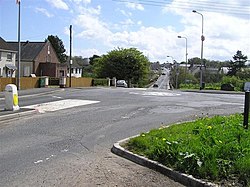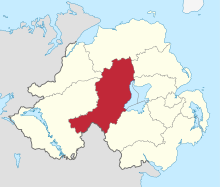Coagh
Coagh
| |
|---|---|
 Looking towards the village, from the County Londonderry side | |
Location within Northern Ireland | |
| Population | 545 (2001 Census) |
| Irish grid reference | H8978 |
| • Belfast | 45 miles |
| District | |
| County | |
| Country | Northern Ireland |
| Sovereign state | United Kingdom |
| Post town | COOKSTOWN MAGHERAFELT |
| Postcode district | BT80 BT45 |
| Dialling code | 028 |
| UK Parliament | |
| NI Assembly | |

Coagh (/koʊk/ KOHK; from Irish An Cuach, meaning 'the hollow'[1]) is a small village in County Tyrone, Northern Ireland, five miles (8 km) east of Cookstown. Part of the village also extends into County Londonderry. It had a population of 545 people in the 2001 Census. It owes its existence to George Butle Conyngham of Springhill, and was founded in 1728 when King George II of Great Britain granted Conyngham a market charter allowing the village to host four fairs yearly.[2] It is situated within Mid-Ulster District.
The village nestles among gentle, low-lying land between the Sperrins and Lough Neagh. The main feature of the village is Hanover Square, which was named after the reigning Hanoverian George II by Conyngham. The village has been an ancient settlement for several thousand years; overlooking Coagh is Tamlaght Stone, a Mesolithic dolmen erected c. 4500 BCE.
History
The Troubles
On 3 June 1991, Provisional Irish Republican Army (IRA) volunteers Lawrence McNally, Peter Ryan and Tony Doris were killed in an ambush by an SAS unit. The British Army stated that the IRA members had been intercepted on their way to an attack. Over 200 rounds were fired at the car.[3]
Education
Coagh has its own primary school, Coagh Primary School, a feeder school for many local schools including Cookstown High School.[citation needed]
Sport
- Coagh United Football Club, which plays in the NIFL Premier Intermediate League
Amenities
Coagh has a surgery which serves local areas, such as Ardboe, Ballinderry, Moortown, Drummullan, The Loup and Moneymore.
Demography
19th century population
The population of the village increased slightly overall during the 19th century:[4][5]
| Year | 1841 | 1851 | 1861 | 1871 | 1881 | 1891 |
|---|---|---|---|---|---|---|
| Population | 388 | 385 | 403 | 526 | 400 | 394 |
| Houses | 90 | 82 | 86 | 115 | 93 | 96 |
21st century population
Coagh is classified as a small village or hamlet by the NI Statistics and Research Agency (NISRA) (i.e. with population between 500 and 1,000 people). On Census day (29 April 2001) there were 545 people living in Coagh. Of these:
- 20.9% were aged under 16 and 20.4% were aged 60 and over
- 48.3% of the population were male and 51.7% were female
- 26.4% were from a Catholic background and 72.8% were from a Protestant background
- 2.3% of people aged 16–74 were unemployed.
For more details see: NI Neighbourhood Information Service
Coagh Townland
The townland is situated in the historic barony of Dungannon Upper and the civil parish of Tamlaght and covers an area of 616 acres.[6]
The population of the townland declined during the 19th century:[4][5]
| Year | 1841 | 1851 | 1861 | 1871 | 1881 | 1891 |
|---|---|---|---|---|---|---|
| Population | 207 | 160 | 136 | 160 | 115 | 100 |
| Houses | 37 | 32 | 29 | 32 | 28 | 22 |
In 1891, the town of Coagh, standing in the townlands of Coagh and Urbal, covered an estimated area of 13 acres.[4]
Politics

Since 1950, Coagh has formed part of the Mid Ulster constituency for Parliamentary elections, with this constituency also being used for elections to the Assembly and other devolved bodies from 1973 onwards. In Parliament, Mid Ulster has been represented by the abstentionist Sinn Féin since 1997, and in devolved elections Sinn Féin has been the largest party in the constituency since the 1996 election to the talks forum.
In local government, Coagh has been part of Mid Ulster District Council since it succeeded Cookstown District Council in 2015. Coagh sits within the ward of the same name in Cookstown DEA. Councillors for this DEA were first elected in 2014 and sat as part of a shadow council until Mid Ulster District Council formally took over in 2015.


While a part of Cookstown District Council, Coagh previously sat within the ward of the same name in Ballinderry DEA from 1981 onwards (with Ballinderry DEA having succeeded the earlier Cookstown Area B which existed from 1973 to 1981).
In both of these DEAs, Sinn Féin has been the largest party since 2011,[7][8] and were joint-largest in 2005, when Ballinderry DEA was uncontested due to the number of candidates being same as the number of available seats, and no election was held. On this occasion, Sinn Féin and the SDLP won two seats each, out of the six available.[9]
Since 1973, Coagh has been represented by the following councillors:
| Election | Councillor
(Party) |
Councillor
(Party) |
Councillor
(Party) |
Councillor
(Party) |
Councillor
(Party) |
Councillor
(Party) |
Councillor
(Party) | |||||||
|---|---|---|---|---|---|---|---|---|---|---|---|---|---|---|
| Cookstown DEA (2014-present) | ||||||||||||||
| 2023 | John McNamee | Cathal Mallaghan | Gavin Bell | Kerri Martin
(SDLP) |
Trevor Wilson
(UUP) |
Wilbert Buchanan
(DUP) |
Eva Cahoon
(DUP) | |||||||
| 2019 | Mark Glasgow
(UUP) | |||||||||||||
| May 2017 defection | Tony Quinn | |||||||||||||
| 2014 | ||||||||||||||
| Ballinderry DEA (1981-2014) | 6 seats (1973-2014) | |||||||||||||
| 2011 | Patrick McAleer | Michael McIvor | Deirdre Mayo
(SDLP) |
Christine McFlynn
(SDLP) |
Robert Kelly
(UUP) |
Samuel McCartney
(DUP) | ||||||||
| 2005 | Patsy McGlone
(SDLP) |
Mary Baker
(SDLP) |
Thomas Greer
(UUP) | |||||||||||
| 2001 | Anne McCrea
(DUP) | |||||||||||||
| 1997 | Seamus Campbell | |||||||||||||
| 1993 | Victor McGahie
(UUP) |
Francis Rock
(SDLP) | ||||||||||||
| 1989 | Francis McNally | John O'Neill
(SDLP) |
Paddy Duffy
(SDLP) |
William McIntyre
(DUP) |
Samuel McCartney
(DUP) | |||||||||
| 1985 | Patrick McAleer | |||||||||||||
| Cookstown Area B (1973-1981) | ||||||||||||||
| 1981 | Paddy Duffy
(SDLP) |
Joseph Davidson
(SDLP) |
Michael McIvor | William McIntyre | Victor McGahie | James Howard
(UUP) | ||||||||
| 1977 | ||||||||||||||
| 1973 | J. J. O'Kane | |||||||||||||
Notable people
- Jimmy Kennedy, Tin Pan Alley composer, grew up here.
- Stuart Dallas (born 1991), Northern Ireland international footballer, grew up in Coagh, having been born in Cookstown.[10][11]
See also
- List of villages in Northern Ireland
- List of towns in Northern Ireland
- List of townlands of County Tyrone
References
- ^ "Coagh". Place Names NI. Retrieved 19 March 2013.
- ^ "Public Record Office of Northern Ireland (PRONI) - nidirect" (PDF). proni.gov.uk. 4 March 2016. Retrieved 12 April 2018.
- ^ "BBC ON THIS DAY | 3 |1991: IRA men shot dead by British army". BBC News. 3 June 1991.
- ^ a b c "Census of Ireland 1851". Enhanced Parliamentary Papers on Ireland. Retrieved 22 March 2013.
- ^ a b "Census of Ireland 1891". Enhanced Parliamentary Papers on Ireland. Retrieved 22 March 2013.
- ^ "Townlands of County Tyrone". IreAtlas Townland Database. Retrieved 19 March 2013.
- ^ "Mid Ulster District Council Elections". www.ark.ac.uk. Retrieved 18 May 2024.
- ^ "Cookstown District Council Elections 1993-2011". www.ark.ac.uk. Retrieved 18 May 2024.
- ^ "Candidates elected - three weeks early!". BelfastTelegraph.co.uk. 13 April 2005. ISSN 0307-1235. Retrieved 18 May 2024.
- ^ Beacom, Steven (30 March 2018). "I'm determined to land medal that my Northern Ireland international brother hasn't got, says Loughgall star Dallas". Belfast Telegraph. ISSN 0307-1235. Retrieved 11 April 2021.
- ^ "Stuart Dallas". irishfa.com. Irish Football Association. Retrieved 11 April 2021.

